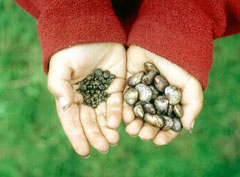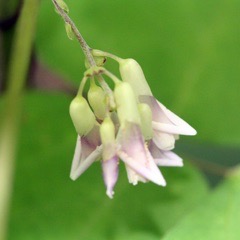 |
|
(c) 2010 Ken Fern & Plants For A Future |
 |
| wikimedia.org/wiki/User:Nonenmac |
Translate this page:
Summary
Physical Characteristics

 Amphicarpaea bracteata is a PERENNIAL CLIMBER growing to 1.5 m (5ft).
Amphicarpaea bracteata is a PERENNIAL CLIMBER growing to 1.5 m (5ft).
See above for USDA hardiness. It is hardy to UK zone 5 and is not frost tender. It is in leaf from May to October, in flower from August to September, and the seeds ripen from September to October. The species is hermaphrodite (has both male and female organs) and is pollinated by Insects.
It can fix Nitrogen.
Suitable for: light (sandy), medium (loamy) and heavy (clay) soils. Suitable pH: mildly acid, neutral and basic (mildly alkaline) soils. It can grow in full shade (deep woodland) or semi-shade (light woodland). It prefers moist soil.
UK Hardiness Map
US Hardiness Map
Synonyms
A. monoica. (L.)Ell. Falcata comosa. (L.)Kuntze.
Plant Habitats
Woodland Garden Sunny Edge; Dappled Shade; Shady Edge; not Deep Shade; Cultivated Beds;
Edible Uses
Edible Parts: Root Seed
Edible Uses:
Seed - raw or cooked[2, 161]. Two types of seed are produced - flowers produced near the ground produce a pod that buries itself just below soil level. These pods contain a single seed are up to 15mm in diameter which can be used as a peanut substitute. They can be harvested throughout the winter and can be eaten raw or cooked[2, 63, 95, 161]. They are sweet and delicious raw with a taste that is more like shelled garden beans than peanuts[183]. Yields are rather low, and it can be a fiddle finding the seeds, but they do make a very pleasant and nutritious snack[K]. Other flowers higher up the plant produce seed pods that do not bury themselves. The seeds in these pods are much smaller and are usually cooked before being eaten[95, 183]. They can be used in all the same ways as lentils and are a good source of protein[K]. The overall crop of these seeds is rather low and they are also fiddly to harvest[K]. Root - cooked[177, 257]. The root is peeled, boiled and then eaten[257]. Fleshy and nutritious according to one report[200], whilst another says that the root is too small to be of much importance in the diet[257]. Our plants have only produced small and stringy roots[K].
References More on Edible Uses
Medicinal Uses
Plants For A Future can not take any responsibility for any adverse effects from the use of plants. Always seek advice from a professional before using a plant medicinally.
An infusion of the root has been used in the treatment of diarrhoea[257]. Externally, the root has been applied to bites from rattlesnakes[257]. A poultice of the pulverized leaves has been applied with any salve to swellings[257].
References More on Medicinal Uses
The Bookshop: Edible Plant Books
Our Latest books on Perennial Plants For Food Forests and Permaculture Gardens in paperback or digital formats.

Edible Tropical Plants
Food Forest Plants for Hotter Conditions: 250+ Plants For Tropical Food Forests & Permaculture Gardens.
More

Edible Temperate Plants
Plants for Your Food Forest: 500 Plants for Temperate Food Forests & Permaculture Gardens.
More

More Books
PFAF have eight books available in paperback and digital formats. Browse the shop for more information.
Shop Now
Other Uses
References More on Other Uses
Cultivation details
Agroforestry Services: Nitrogen Agroforestry Services: Understory legume Historic Crop Management: Fodder Management: Standard Staple Crop: Protein
Requires a moist humus-rich soil in a shady position[200]. The young shoots in spring can be damaged by late frosts[K]. The hog peanut has occasionally been cultivated for its edible seed which has been used as a peanut substitute[183]. Yields at present, however, are rather low[K]. Two types of blossom are produced by the plant - those produced from the leaf axils mostly abort but a few seeds are produced[95]. Solitary, inconspicuous cleistogamous flowers are produced on thread-like stems near the root and, after flowering, the developing seedpods bury themselves into the soil in a manner similar to peanuts[95, 274]. This species has a symbiotic relationship with certain soil bacteria, these bacteria form nodules on the roots and fix atmospheric nitrogen. Some of this nitrogen is utilized by the growing plant but some can also be used by other plants growing nearby[200]. For polyculture design as well as the above-ground architecture (form - tree, shrub etc. and size shown above) information on the habit and root pattern is also useful and given here if available. A self-seeding plant [1-2]. Growth habit is herbaceous. Growth habit is a single or multiple shooting vine from a crown [1-2]. The root pattern is fibrous dividing into a large number of fine roots [1-2].
Carbon Farming
-
Agroforestry Services: Nitrogen
Plants that contribute to nitrogen fixation include the legume family – Fabaceae.
-
Agroforestry Services: Understory legume
Legume vegetation, especially the trees and shrubs growing between the forest canopy and the forest floor.
-
Historic Crop
These crops were once cultivated but have been abandoned. The reasons for abandonment may include colonization, genocide, market pressures, the arrival of superior crops from elsewhere, and so forth.
-
Management: Fodder
Non-destructive management systems maintaining the soil organic carbon.
-
Management: Standard
Plants grow to their standard height. Harvest fruit, seeds, or other products. Non-Destructive management systems.
-
Staple Crop: Protein
(16+ percent protein, 0-15 percent oil). Annuals include beans, chickpeas, lentils, cowpeas, and pigeon peas. Perennials include perennial beans, nuts, leaf protein concentrates, and edible milks.
References Carbon Farming Information and Carbon Sequestration Information
Temperature Converter
Type a value in the Celsius field to convert the value to Fahrenheit:
Fahrenheit:
The PFAF Bookshop
Plants For A Future have a number of books available in paperback and digital form. Book titles include Edible Plants, Edible Perennials, Edible Trees,Edible Shrubs, Woodland Gardening, and Temperate Food Forest Plants. Our new book is Food Forest Plants For Hotter Conditions (Tropical and Sub-Tropical).
Shop Now
Plant Propagation
Seed - pre-soak for 12 hours in warm water and then sow in spring in a semi-shaded position in a greenhouse. Germination usually takes place within a few weeks. When large enough to handle, prick the seedlings out into individual pots and grow them on in the greenhouse for their first winter, planting them out in late spring or early summer. Division. We have been unable to divide this plant because it only makes a small taproot. However, many of the seeds are produced under the ground and these can be harvested like tubers and potted up to make more plants.
Other Names
If available other names are mentioned here
Native Range
NORTHERN AMERICA: Canada, Québec, Nova Scotia, Ontario, New Brunswick, Saskatchewan (east), Manitoba (south), United States, Connecticut, Indiana, Maine, Massachusetts, Michigan, New Hampshire, New Jersey, New York, Ohio, Pennsylvania, Rhode Island, Vermont, West Virginia, Illinois, Iowa, Kansas, Minnesota, Missouri, Nebraska, North Dakota, Oklahoma, South Dakota, Wisconsin, Montana, Alabama, Arkansas, Florida (north), Georgia, Kentucky, Louisiana, Maryland, Mississippi, North Carolina, South Carolina, Tennessee, Virginia, Texas (east),
Weed Potential
Right plant wrong place. We are currently updating this section.
Please note that a plant may be invasive in one area but may not in your area so it's worth checking.
Conservation Status
IUCN Red List of Threatened Plants Status :

Growth: S = slow M = medium F = fast. Soil: L = light (sandy) M = medium H = heavy (clay). pH: A = acid N = neutral B = basic (alkaline). Shade: F = full shade S = semi-shade N = no shade. Moisture: D = dry M = Moist We = wet Wa = water.
Now available:
Food Forest Plants for Mediterranean Conditions
350+ Perennial Plants For Mediterranean and Drier Food Forests and Permaculture Gardens.
[Paperback and eBook]
This is the third in Plants For A Future's series of plant guides for food forests tailored to
specific climate zones. Following volumes on temperate and tropical ecosystems, this book focuses
on species suited to Mediterranean conditions—regions with hot, dry summers and cool, wet winters,
often facing the added challenge of climate change.
Read More
Expert comment
Author
(L.)Rickett.&Stafleu.
Botanical References
43200235
Links / References
For a list of references used on this page please go here
Readers comment